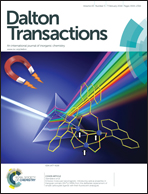Graphene oxide capturing surface-fluorinated TiO2 nanosheets for advanced photocatalysis and the reveal of synergism reinforce mechanism
Abstract
Surface-fluorinated TiO2 (F–TiO2) nanosheets with exposed (001) facets were synthesized from a scalable hydrothermal treatment assisted by a specific stabilization effect of fluorine ions on the (001) facets. Assembly of F–TiO2 on graphene oxide (GO) sheets into GO/F–TiO2 hybrid in aqueous solution was further achieved by making use of the surfactant role of GO. Photocatalytic properties of GO/F–TiO2 hybrid were evaluated under 365 nm UV light irradiation for photodegradation of methylene blue (MB). An optimal GO content has been determined to be 3 wt%, and the corresponding apparent pseudo-first-order rate constant Kapp is 0.0493 min−1, 3 times and 4 times more than that of pure TiO2 nanosheets and commercial P25 photocatalyst, respectively. To reveal the synergism reinforce mechanism of GO/F–TiO2 hybrid, photo absorption, surface absorption, and the photoelectrochemical current properties have been intensively studied. We found that enhanced electron–hole separation has been the key issue for the reinforcement of photocatalytic performance. F–TiO2 with exposed (001) facet has stronger electron–hole separation resulting in a higher photoelectrochemical current than that of P25 photocatalyst. Moreover, hybridization of F–TiO2 with GO could further increase the photoelectrochemical current and the largest current for the optimal weight fraction of GO is in good accordance with the photocatalysis performance. The GO/F–TiO2 interface junction that favors the electron–hole separation was attributed to the photoelectrochemical current enhancement.


 Please wait while we load your content...
Please wait while we load your content...